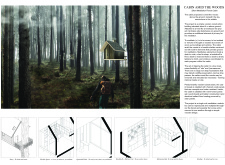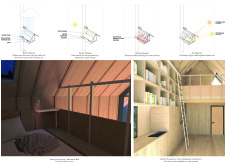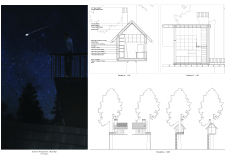5 key facts about this project
The architectural project "Cabin Amid the Woods" is a designed retreat situated in a forest setting, aimed at providing a space for meditation and reflection. The cabin’s elevation above the ground minimizes its environmental impact while facilitating unobstructed views of the surrounding landscape. This retreat serves multiple functions, including a space for solitude, artistic creation, and a connection with nature.
The overall concept is to create a seamless integration between the structure and its environment. The design encourages interaction with the natural surroundings and has been carefully crafted to respect the flora and fauna of the area. The cabin features an open layout, allowing for flexibility in use and adaptation to different activities. The primary materials used in its construction are sustainably sourced woods, which contribute to both the structural integrity and aesthetic quality of the project.
Unique Design Approaches and Functions
A notable aspect of this project is its elevated design, characteristic of treehouses yet wholly modern. The cabin is situated approximately four meters above the ground, providing views that enrich the meditative experience while ensuring minimal disruption to the forest floor. This characteristic enhances user privacy and fosters a sense of seclusion that is crucial for introspective practices.
The interior design features configurable spaces, including an openable table suited for various activities such as dining and working. The selection of Latvian ash wood for the interior surfaces adds a welcoming ambiance and coziness, supporting the cabin's function as a restful retreat. The cabin also incorporates advanced energy management systems, including solar panels for renewable energy and electrical radiant floor heating for year-round comfort.
Sustainable Practices and Architectural Integrity
The architectural design emphasizes sustainability through the incorporation of rainwater harvesting systems and greywater recycling for landscaping needs. The cabin’s minimal footprint not only reduces physical impact but also supports ecological preservation. Attention to detail is evident in the selection of materials, such as charnel wood cladding that demonstrates durability and weather resistance while maintaining an aesthetically pleasing façade.
The use of large glass windows enables natural light to flood the cabin, establishing a direct connection between interior spaces and the natural environment. This integration into the landscape is further enhanced by the cabin's design, which encourages users to engage with their surroundings, promoting a sense of peace and enhanced well-being.
To explore the design and functionalities of "Cabin Amid the Woods" in greater detail, readers are encouraged to review the architectural plans, sections, and design documents that provide a comprehensive view of this project. Understanding the architectural ideas and practical implementations may offer further insights into the thoughtful approaches employed in this retreat.





















































